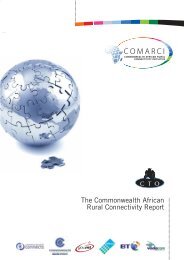Guide to measuring information and ... - unesdoc - Unesco
Guide to measuring information and ... - unesdoc - Unesco
Guide to measuring information and ... - unesdoc - Unesco
You also want an ePaper? Increase the reach of your titles
YUMPU automatically turns print PDFs into web optimized ePapers that Google loves.
ED40 Ratio of learners-<strong>to</strong>-teachers using ICT <strong>to</strong> teach (for ISCED levels 1-3)<br />
Definition:<br />
Number of learners enrolled in grades with ICT-assisted<br />
instruction divided by the number of teachers currently<br />
teaching subject(s) using ICT-facilities in school for<br />
ISCED levels 1-3.<br />
Data requirement:<br />
(LICT) Number of learners enrolled in grades with ICTassisted<br />
instruction for ISCED levels 1-3.<br />
(refer <strong>to</strong> questionnaire item E.1.3)<br />
(TI) Number of teachers currently teaching subject(s)<br />
using ICT facilities for ISCED levels 1-3.<br />
(refer <strong>to</strong> questionnaire item D.1.4)<br />
Formula:<br />
3<br />
<br />
h1<br />
3<br />
TI<br />
h1<br />
Where:<br />
LICT t<br />
h<br />
LICT<br />
t<br />
h<br />
t<br />
h<br />
- 72 -<br />
Purpose:<br />
To measure the workload of teachers using ICT <strong>to</strong><br />
teach in order <strong>to</strong> assess if the number of teachers is<br />
adequate for the size of the target group of learners.<br />
Method of collection:<br />
Administrative data collection through annual school<br />
census (or extract data from school records).<br />
Data source(s):<br />
Statistical unit of the Ministry of Education or,<br />
alternatively, the national statistical office.<br />
= Number of learners enrolled in grades with ICT-assisted instruction at education level h in school-<br />
year t<br />
TI t<br />
h = Number of teachers currently teaching subject(s) using ICT facilities at education level h in schoolyear<br />
t<br />
Analysis <strong>and</strong> interpretation:<br />
A high learner-<strong>to</strong>-teacher ratio suggests that each<br />
teacher has <strong>to</strong> be responsible for a large number of<br />
learners. It is generally assumed that a low ratio signifies<br />
smaller classes, which enables the teacher <strong>to</strong> pay more<br />
attention <strong>to</strong> individual learners, which may in turn result<br />
in a better performance of the learners.<br />
When calculated <strong>and</strong> analysed by ISCED levels,<br />
geographical regions, urban/rural areas, by school <strong>and</strong><br />
by basic computer skills classes, this indica<strong>to</strong>r can help<br />
<strong>to</strong> measure potential discrepancies in the ratio between<br />
learners <strong>and</strong> teachers in different ICT-assisted<br />
instruction programmes.<br />
Methodological <strong>and</strong> definition issues or<br />
operational limitations:<br />
This indica<strong>to</strong>r is a very rough measure of teachers’<br />
workload <strong>and</strong> teaching conditions. For this indica<strong>to</strong>r <strong>to</strong><br />
be accurate <strong>and</strong> meaningful, the number of part-time<br />
teachers should be converted, where feasible, in<strong>to</strong><br />
‘full-time equivalent’ teachers. Also, this indica<strong>to</strong>r<br />
does not take in<strong>to</strong> account differences in teachers’<br />
experience <strong>and</strong> status, teaching style, teaching<br />
materials <strong>and</strong> variations in classroom conditions, etc.<br />
all fac<strong>to</strong>rs that could affect the quality of<br />
teaching/learning.
















